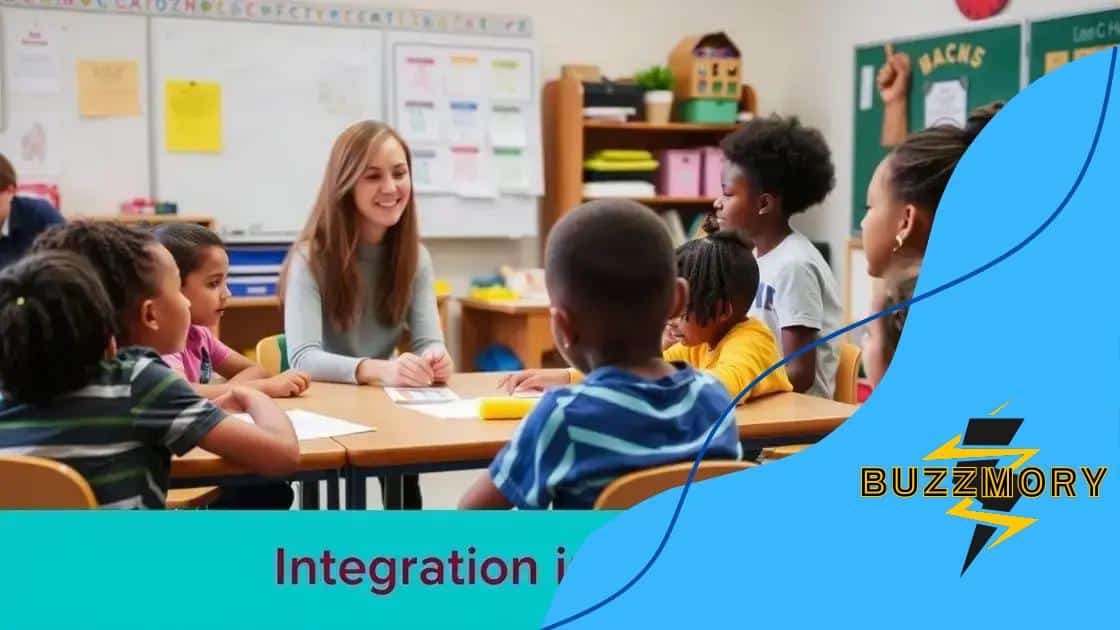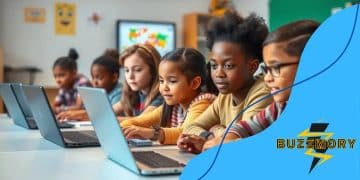The importance of social-emotional learning in modern education

The importance of social-emotional learning (SEL) in modern education lies in its ability to enhance students’ emotional well-being, improve academic performance, and foster critical life skills necessary for success.
The importance of social-emotional learning in modern education cannot be overstated. It’s about more than academics; it helps shape well-rounded individuals ready to tackle life’s challenges. What if students learned to manage emotions and build strong relationships while in school?
Understanding social-emotional learning
Understanding social-emotional learning is essential for creating supportive learning environments. It focuses on the skills that help students manage their emotions, build relationships, and make responsible decisions. By integrating these skills into education, we can help students thrive both academically and personally.
Key Components of SEL
Social-emotional learning includes several core components:
- Self-awareness: Recognizing one’s emotions and values.
- Self-management: Managing emotions and behaviors effectively.
- Social awareness: Understanding and respecting others’ perspectives.
- Relationship skills: Building healthy relationships through communication and teamwork.
- Responsible decision-making: Making ethical, constructive choices.
Each of these components plays a vital role in helping students navigate their social world. For instance, self-awareness enables students to understand their feelings, while social awareness helps them connect with peers from diverse backgrounds. Through activities like group discussions and team projects, students can practice these skills in real-life situations.
Benefits of Understanding SEL
There are numerous benefits to understanding and implementing social-emotional learning in schools. Schools that emphasize SEL find that students typically display:
- Improved academic performance and focus.
- Better relationships with peers and teachers.
- Increased motivation and engagement in classroom activities.
- Reduction in disciplinary issues.
Furthermore, fostering an environment where students feel safe and valued lays the foundation for lifelong success. Implementing SEL can transform not just classrooms, but entire communities by creating empathetic and resilient individuals.
Benefits of social-emotional skills
Benefits of social-emotional skills extend far beyond the classroom. These skills dramatically enhance a student’s ability to succeed in all areas of life. When children learn to navigate their emotions and build strong relationships, they are better prepared for challenges.
Impact on Academic Performance
One significant benefit is improved academic performance. Students with strong social-emotional skills tend to be more engaged in their studies. They are better equipped to handle stress and distractions, which leads to higher grades. These students can focus on learning rather than managing their emotions during difficult situations.
- Higher attendance rates
- Increased participation in class
- Enhanced focus and concentration
- Improved test scores
Additionally, social-emotional skills foster a positive learning environment. When students feel safe and connected, they can collaborate effectively with their peers. This collaboration leads to shared learning experiences that benefit everyone involved.
Emotional Well-being
Another notable benefit is the enhancement of emotional well-being. Children who practice social-emotional skills can better express their feelings and cope with challenges. They learn to identify their emotions and the emotions of others, leading to greater empathy.
Strong emotional intelligence contributes to healthier relationships, both in school and later in life. With better communication skills, students can resolve conflicts amicably and build supportive friendships. This foundation prepares them for future professional environments where teamwork and cooperation are essential.
Long-term Benefits
The benefits of these skills are not limited to childhood. As young people grow, the ability to manage emotions and build connections becomes even more critical. They carry these skills into adulthood, enhancing their personal and professional lives.
- Increased job satisfaction
- Better leadership abilities
- Stronger personal relationships
- Greater resilience in the face of adversity
Ultimately, investing in social-emotional learning leads to well-rounded individuals who can contribute positively to society. These skills are essential for 21st-century learners who must adapt to a rapidly changing world.
Integrating SEL into the curriculum

Integrating social-emotional learning (SEL) into the curriculum is crucial for nurturing well-rounded students. This approach enhances not just academic skills, but also emotional intelligence. Teachers play an important role in making this integration successful.
Strategies for Integration
There are various strategies that schools can adopt to effectively integrate SEL in their curriculum. Here are some key methods that can be employed:
- Incorporating SEL into daily lessons: Teachers can weave emotional learning into their subject matter, providing opportunities for discussions about feelings and relationships.
- Adopting specific programs: Schools may choose structured SEL programs that offer curricula designed around emotional skills.
- Fostering a positive environment: Creating a safe space in the classroom encourages open discussions about emotions and peer interactions.
- Encouraging group activities: Collaborative tasks allow students to practice social skills and improve their ability to work in teams.
These strategies are essential for developing emotional literacy among students. By embedding SEL concepts across various subjects, educators can ensure that students gain important life skills alongside academic knowledge.
Training Educators
Another vital aspect of integrating SEL into the curriculum is providing educators with the necessary training and resources. Teachers need to understand the principles of SEL and how to effectively teach these skills in their classrooms. Professional development workshops can offer teachers tools and techniques for incorporating SEL.
Moreover, educators should model social-emotional skills themselves. When teachers practice self-regulation and empathy, students are more likely to emulate these behaviors. Building these skills in educators leads to a more supportive learning environment, benefiting both students and teachers.
Measuring Success
Finally, it’s important to measure the success of SEL integration. Schools can assess the impact of SEL on students using various metrics, such as academic performance and behavioral changes. Conducting surveys and gathering feedback from students helps gauge how well SEL is being received.
- Tracking academic improvements
- Observing changes in student behavior
- Evaluating peer relationships
- Gathering feedback from teachers and parents
Understanding the effectiveness of SEL initiatives allows schools to adapt and enhance their programs to better serve students’ needs.
Challenges in implementing SEL
Challenges in implementing social-emotional learning (SEL) arise in various forms and can impact the effectiveness of educational programs. Understanding these obstacles is important for creating a successful SEL framework in schools.
Resistance to Change
One of the primary challenges is resistance to change from faculty and administration. Many educators have been trained in traditional teaching methods. They may feel unsure about how to incorporate SEL into their existing curricula. This resistance can slow down the adoption of new practices.
- Fear of additional workload
- Lack of confidence in teaching SEL
- Concerns over relevance to academic subjects
Overcoming this challenge requires strong leadership and professional development. Schools should provide resources and ongoing training to help educators feel more comfortable with SEL.
Limited Resources
Another challenge is the lack of resources allocated for SEL programs. Many schools might struggle to secure funding for SEL training or materials. In some cases, educators may simply lack access to effective SEL curricula.
To tackle this issue, schools can look for grants or partnerships with community organizations. Collaborating with local mental health professionals can also provide valuable support for SEL initiatives.
Diverse Student Needs
Implementing SEL can also be complicated by the diverse needs of students. Each student comes with a unique set of experiences and emotional challenges. A one-size-fits-all approach may not work effectively.
Teachers must differentiate their SEL instruction to accommodate various backgrounds, cultures, and individual experiences. This can require additional training and resources to meet the diverse needs of students effectively.
Data Collection and Assessment
Finally, measuring the success of SEL programs presents its own set of challenges. Schools need effective ways to assess the impact of SEL instruction on student behavior and academic performance. Collecting pertinent data while maintaining student privacy can be difficult.
- Identifying appropriate metrics for success
- Balancing quantitative data with qualitative feedback
- Ensuring confidentiality and ethical standards
Addressing these challenges ensures that SEL implementation is both effective and comprehensive. By recognizing potential obstacles, schools can better prepare to create a supportive environment that fosters emotional growth.
Future of social-emotional learning
The future of social-emotional learning (SEL) holds great promise as educators increasingly understand its importance. As we look ahead, several trends and developments are shaping how SEL is integrated into education.
Increased Focus on Mental Health
One significant trend is the growing focus on mental health. As more studies highlight the connection between emotional well-being and academic success, schools are prioritizing SEL in their curricula. This shift is important for equipping students to handle stress, anxiety, and other mental health challenges.
- More mental health resources in schools
- Training for educators on mental health awareness
- Partnerships with mental health professionals
By addressing mental health proactively, schools can create environments where students feel safe and supported.
Integration of Technology
Another exciting development is the integration of technology in SEL programs. Digital tools offer innovative ways to engage students in developing their social-emotional skills. Apps and online platforms can provide interactive activities, virtual counseling, and resources for teachers.
These technologies can enhance the learning experience, making SEL more accessible. For instance, gamified applications help students practice skills in a fun and engaging way.
Personalized Learning
The rise of personalized learning is also impacting the future of SEL. Educators are beginning to tailor SEL programs to meet the unique needs of each student. This approach ensures that students receive support based on their individual experiences and challenges.
By focusing on personalization, educators can better address the diverse emotional landscapes of their students. This may involve developing specific interventions or curricula that cater to different learning styles.
Collaboration with Families and Communities
Finally, collaboration with families and communities is becoming increasingly essential. Schools are recognizing that supporting students’ social-emotional development requires partnerships outside the classroom. Engaging parents and community organizations can provide additional resources and support.
- Workshops for parents on SEL
- Community programs that promote emotional well-being
- Shared goals between families and schools
This collaborative approach strengthens the support system around students, making SEL efforts more impactful and sustainable.
FAQ – Frequently Asked Questions about Social-Emotional Learning
What is social-emotional learning (SEL)?
SEL is a process through which students learn to manage their emotions, set goals, show empathy for others, maintain positive relationships, and make responsible decisions.
Why is SEL important in education?
SEL is important because it helps enhance students’ emotional well-being, which is linked to improved academic performance and social skills.
How can schools effectively integrate SEL into their curriculum?
Schools can integrate SEL by incorporating it into daily lessons, adopting specific programs, and fostering a positive learning environment.
What challenges do schools face when implementing SEL?
Challenges include resistance to change from educators, limited resources for training, and addressing the diverse needs of students.





